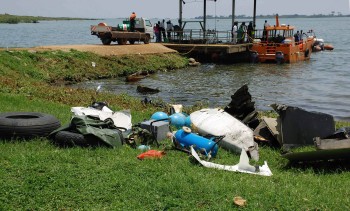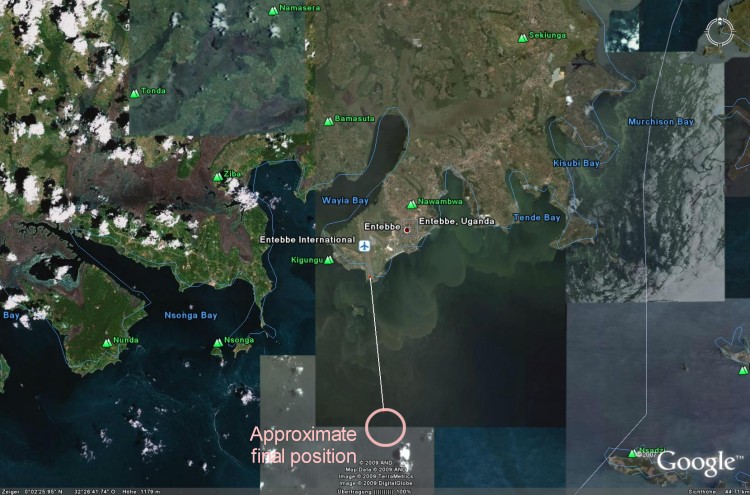On Jul 23rd 2025 The Aviation Herald received information, that the final report had been released by the Republic of Uganda, dated Jan 13th 2010, the PDF carrying the date Jul 15th 2020.
The Republic of Uganda released their final report concluding the probable causes of the crash were:
The investigation was unable to determine conclusively the probable cause primarily because of the absence of substantial aircraft wreckage to examine, the lack of flight recorders to evaluate the performance of the crew and the aircraft, as well as insufficient forensic evidence.
The accident could be explained by one or a combination of a loss of engine power, aircrafi malfLmction of the flight controls and related systems, pilot impairment/incapacitation, spatial disorientation, inattentiveness to altitude, and inadequate handling of the aircraft.
The loss of engine power was possible based on witness accounts, a recent event in which a loss of power occurred and the fact that the engines had exceeded their service life. However, the lack of the engines to examine during the investigation precluded detem1ination of their mechanical condition at the time of the accident.
The crew's ability to conduct flight duties under normal, abnormal, and emergency conditions was not assured because of insufficient records regarding the crew's experience, training, and certification. Also, the possibiliiy of alcohol consumption, fatigue, insufficient sleep and lack of the required minimum crew could have contributed to degraded perfonnance on either one or both ofthe pilots.
The report analysed:
1. Visual meteorological conditions existed at the time and there was no evidence that weather was a factor.
2. Air traffic control services were normal and not a factor.
3. The runway inspection prior to takeoff did not disclose evidence of foreign objects.
4. Witnesses reported observing a fire on the aircraft shortly after takeoff; however, the investigation lacked the physical evidence to conilrm these reports.
5. The crew and passengers died of crash injuries and there was no evidence of burns on the bodies.
6. Post mortem examination and the inspection of the recovered aircraft debris did not disclose evidence of an in-flight fire.
7. The aircraft wreckage was located within the confines of the accident site which indicates that the aircraft disintegrated on impact.
8. The Search and Rescue team was hampered due to inadequate personnel training and equipment along with the inoperative emergency almm system. Also, the investigation revealed the emergency response office was not manned at the time of the accident.
9. Flight recorders were not recovered and therefore the investigation could not determine the aircraft and crew perfotmance during the accident flight.
10. The aircraft was within maximum takeoff weight limitations at the time of the accident. The aircraft center-of-gravity was not determined.
11. Apart from the flight engineer, the investigation did not determine that the crew were properly trained, experienced, and proficient in accordance with applicable regulatory requirements.
Uganda's Ministry of Transport have concluded their final report into the crash stating, that no definitive cause of the crash could be identified due to lack of vital parts like black boxes and crucial parts from the aircraft.
However, the commission states that according to aircraft documentation the aircraft had reached its end of life by 1998. There is no evidence that the aircraft underwent maintenance to extend its life despite claims by Aerolift, that such maintenace took place.
The commission went on to say that the airplane had returned to Entebbe in December 2008 already after two of its engines lost power shortly after takeoff. The two engines were replaced and the airplane departed Entebbe 13 days later but had another engine failure in Johannesburg (South Africa) in January 2009. The airplane continued to fly after another 9 days on the ground. According to documentation all 4 engines had exceeded their end of life, despite claims by Aerolift that the engines had been overhauled and were certified to operate no evidence of such overhaul work was found.
The commission further stated, that the 4 flight crew had little or no sleep the night before departure having been engaged in social activities the previous evening until late night before departing for the airport at 3am, the crew was likely to suffer from fatigue. The navigator of the ill-fated flight was not in possession of a valid license, he instead had a forged license that had originally been issued to another person.
According to ground witnesses both left hand engines were on fire as the aircraft climbed out of Entebbe.
Uganda's Transport and Works Ministry said, that the air traffic controllers at Entebbe's control tower watched the airplane as it took off and saw two engines on fire immediately after liftoff. Investigation results so far have ruled out any act of sabotage or terrorism countering spreading rumours, that the airplane may have been shot down.
The Information Ministry said, that the tail section of the airplane has been found by fishermen 27km from the crash site. 10 body parts have been recovered so far, DNA testing will be needed to identify the body.
 Recovered debris of the IL-76
Recovered debris of the IL-76
(Photo: AFP/Peter Busomoke) An Aerolift (Namibia) Ilyushin IL-76 chartered by Dynacorp on behalf of the African Mission to Somalia (AMISOM), registration S9-SAB performing a charter freight flight from Entebbe (Uganda) to Mogadishu (Somalia) with 7 passengers and 4 crew on board, crashed into Lake Victoria about 5.5nm (10km) south of the airport shortly after takeoff from Entebbe at 05:14 local (02:14Z) and sank at one of the deepest points of Lake Victoria. All 11 people on board are feared dead, no bodies have yet been recovered or detected.
The airplane carried tents and water purifiers.
The Ugandan Civil Aviation Authority reported the airport's emergency services, Ugandan People's Defense Forces, the Ministry of Transport and Work as well as Ugandan Marine units are on the scene for salvage efforts. There are little hopes for survivors amongst the 4 crew and 7 passengers.
Eyewitnesses on the ground reported, that 2 of the 4 engines of the aircraft flamed out during the initial climb.
A police officer at Entebbe Airport reported, that the IL-76 took off just after Kenya Airways flight KQ-417 to Nairobi and sounded awful during its takeoff run and liftoff. It caught fire soon after liftoff.
Two fishermen were about 10 km south of the airport in their boat dropping nets, when they observed the airplane spinning towards them. The wave of impact capsized their boat.
Aerolift lost another Antonov 12 freighter just 17 days ago in Luxor, see Crash: Aerolift AN12 at Luxor on Feb 20th 2009, engine fire
Metars:
HUEN 090400Z 35007KT 9999 FEW019 FEW022CB BKN120 21/19 Q1017
HUEN 090300Z 35005KT 9999 FEW018 FEW020CB BKN110 21/19 Q1016
HUEN 090200Z 25005KT 9999 FEW018 FEW020CB OVC110 21/19 Q1016
HUEN 090100Z 25003KT 9999 FEW018 FEW020CB BKN110 21/19 Q1015
HUEN 082100Z 30005KT 9999 FEW023 FEW025CB 21/20 Q1015
Map of Entebbe (Courtesy Google Earth):

The Republic of Uganda released their final report concluding the probable causes of the crash were:
The investigation was unable to determine conclusively the probable cause primarily because of the absence of substantial aircraft wreckage to examine, the lack of flight recorders to evaluate the performance of the crew and the aircraft, as well as insufficient forensic evidence.
The accident could be explained by one or a combination of a loss of engine power, aircrafi malfLmction of the flight controls and related systems, pilot impairment/incapacitation, spatial disorientation, inattentiveness to altitude, and inadequate handling of the aircraft.
The loss of engine power was possible based on witness accounts, a recent event in which a loss of power occurred and the fact that the engines had exceeded their service life. However, the lack of the engines to examine during the investigation precluded detem1ination of their mechanical condition at the time of the accident.
The crew's ability to conduct flight duties under normal, abnormal, and emergency conditions was not assured because of insufficient records regarding the crew's experience, training, and certification. Also, the possibiliiy of alcohol consumption, fatigue, insufficient sleep and lack of the required minimum crew could have contributed to degraded perfonnance on either one or both ofthe pilots.
The report analysed:
1. Visual meteorological conditions existed at the time and there was no evidence that weather was a factor.
2. Air traffic control services were normal and not a factor.
3. The runway inspection prior to takeoff did not disclose evidence of foreign objects.
4. Witnesses reported observing a fire on the aircraft shortly after takeoff; however, the investigation lacked the physical evidence to conilrm these reports.
5. The crew and passengers died of crash injuries and there was no evidence of burns on the bodies.
6. Post mortem examination and the inspection of the recovered aircraft debris did not disclose evidence of an in-flight fire.
7. The aircraft wreckage was located within the confines of the accident site which indicates that the aircraft disintegrated on impact.
8. The Search and Rescue team was hampered due to inadequate personnel training and equipment along with the inoperative emergency almm system. Also, the investigation revealed the emergency response office was not manned at the time of the accident.
9. Flight recorders were not recovered and therefore the investigation could not determine the aircraft and crew perfotmance during the accident flight.
10. The aircraft was within maximum takeoff weight limitations at the time of the accident. The aircraft center-of-gravity was not determined.
11. Apart from the flight engineer, the investigation did not determine that the crew were properly trained, experienced, and proficient in accordance with applicable regulatory requirements.
Uganda's Ministry of Transport have concluded their final report into the crash stating, that no definitive cause of the crash could be identified due to lack of vital parts like black boxes and crucial parts from the aircraft.
However, the commission states that according to aircraft documentation the aircraft had reached its end of life by 1998. There is no evidence that the aircraft underwent maintenance to extend its life despite claims by Aerolift, that such maintenace took place.
The commission went on to say that the airplane had returned to Entebbe in December 2008 already after two of its engines lost power shortly after takeoff. The two engines were replaced and the airplane departed Entebbe 13 days later but had another engine failure in Johannesburg (South Africa) in January 2009. The airplane continued to fly after another 9 days on the ground. According to documentation all 4 engines had exceeded their end of life, despite claims by Aerolift that the engines had been overhauled and were certified to operate no evidence of such overhaul work was found.
The commission further stated, that the 4 flight crew had little or no sleep the night before departure having been engaged in social activities the previous evening until late night before departing for the airport at 3am, the crew was likely to suffer from fatigue. The navigator of the ill-fated flight was not in possession of a valid license, he instead had a forged license that had originally been issued to another person.
According to ground witnesses both left hand engines were on fire as the aircraft climbed out of Entebbe.
Uganda's Transport and Works Ministry said, that the air traffic controllers at Entebbe's control tower watched the airplane as it took off and saw two engines on fire immediately after liftoff. Investigation results so far have ruled out any act of sabotage or terrorism countering spreading rumours, that the airplane may have been shot down.
The Information Ministry said, that the tail section of the airplane has been found by fishermen 27km from the crash site. 10 body parts have been recovered so far, DNA testing will be needed to identify the body.
 Recovered debris of the IL-76
Recovered debris of the IL-76 (Photo: AFP/Peter Busomoke) An Aerolift (Namibia) Ilyushin IL-76 chartered by Dynacorp on behalf of the African Mission to Somalia (AMISOM), registration S9-SAB performing a charter freight flight from Entebbe (Uganda) to Mogadishu (Somalia) with 7 passengers and 4 crew on board, crashed into Lake Victoria about 5.5nm (10km) south of the airport shortly after takeoff from Entebbe at 05:14 local (02:14Z) and sank at one of the deepest points of Lake Victoria. All 11 people on board are feared dead, no bodies have yet been recovered or detected.
The airplane carried tents and water purifiers.
The Ugandan Civil Aviation Authority reported the airport's emergency services, Ugandan People's Defense Forces, the Ministry of Transport and Work as well as Ugandan Marine units are on the scene for salvage efforts. There are little hopes for survivors amongst the 4 crew and 7 passengers.
Eyewitnesses on the ground reported, that 2 of the 4 engines of the aircraft flamed out during the initial climb.
A police officer at Entebbe Airport reported, that the IL-76 took off just after Kenya Airways flight KQ-417 to Nairobi and sounded awful during its takeoff run and liftoff. It caught fire soon after liftoff.
Two fishermen were about 10 km south of the airport in their boat dropping nets, when they observed the airplane spinning towards them. The wave of impact capsized their boat.
Aerolift lost another Antonov 12 freighter just 17 days ago in Luxor, see Crash: Aerolift AN12 at Luxor on Feb 20th 2009, engine fire
Metars:
HUEN 090400Z 35007KT 9999 FEW019 FEW022CB BKN120 21/19 Q1017
HUEN 090300Z 35005KT 9999 FEW018 FEW020CB BKN110 21/19 Q1016
HUEN 090200Z 25005KT 9999 FEW018 FEW020CB OVC110 21/19 Q1016
HUEN 090100Z 25003KT 9999 FEW018 FEW020CB BKN110 21/19 Q1015
HUEN 082100Z 30005KT 9999 FEW023 FEW025CB 21/20 Q1015
Map of Entebbe (Courtesy Google Earth):

This article is published under license. Article Source
Published Date















